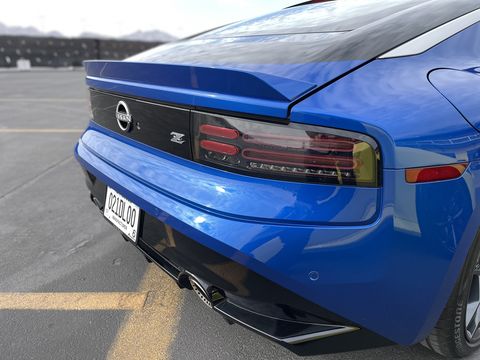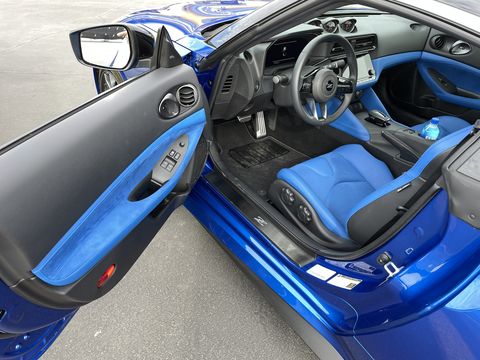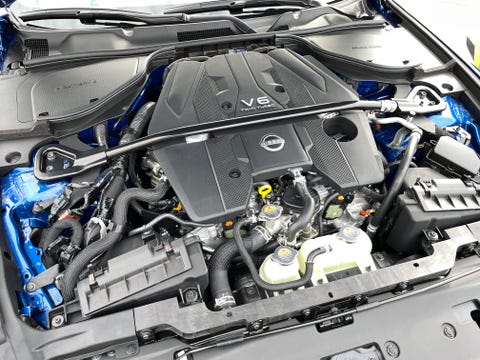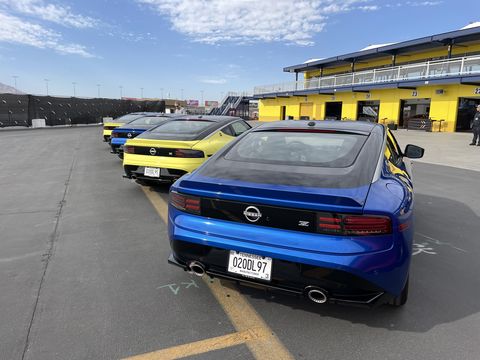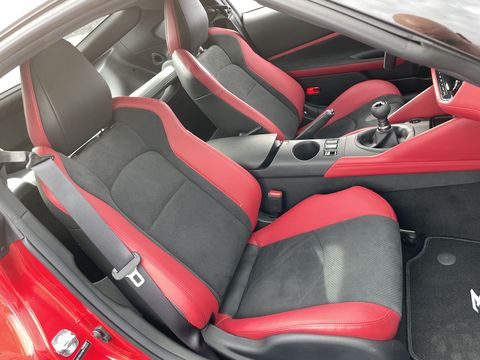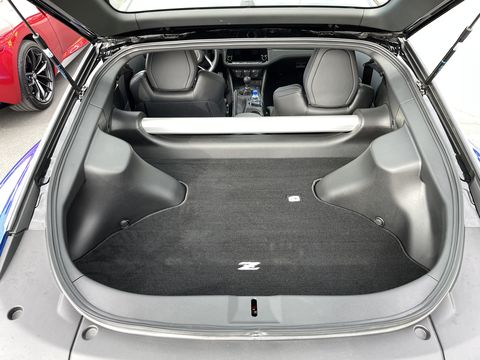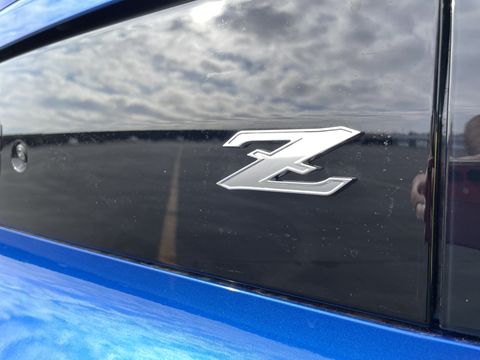In the big business that is the car business, sports cars are a niche that’s shrinking. A sideline. Almost irrelevant. That’s what’s glorious about Nissan’s new Z. And it’s why we care so much. It’s not merely a new sports car; the new Z is Nissan re-committing to analog, agile and fun two-seat sports coupes. It’s Nissan being unreasonable, and then selling the result for a reasonable amount of money. As in reasonably cheap. Pricing starts at $41,015.
Plus, it’s practical enough to use every day. That’s reasonable too.
It’s no secret that the new Z rides on the same fundamental architecture as the outgoing 370Z, which rides on the same fundamental architecture as the 350Z, which dates way back to 2002. That’s two full decades. It’s 21 years counting the 2001 Infiniti G-Series that introduced the “FM” platform. My inner negative Nancy says it’s time for a full redesign, as this one is old enough to graduate college this year. The optimistic me considers how good this platform has been since its birth, and why the Z has been a totally relevant sports car for such a long time.
There’s also that “business” case thing. Though “GT-R Godfather” Hiroshi Tamura is clearly proud of the new car in the tech presentation, he’s not-so subtly imploring us journalists to understand that the only way there was going to be a new generation Z was if the platform carried over. For worse, it means the new Z isn’t “all new.” For better, it means they didn’t birth “twins.” With twin sports cars, one brand always shines through. The Supra is really a BMW in all the ways that matter. The 86 is really a Subaru, and you’re not going to convince me otherwise. Imagine the Z was also a Ford Capri? That would suck.
But don’t despair. It is mostly new in the ways that matter. It has fresh new bodywork with throwback details from different Z generations. At the front, it largely resembles a retro-futuristic 240Z, with a gaping, squared off maw and headlights with LED rings that mimic the reflections of the “cutout” lights from the ’70s. It looks better in person than it does in photos with the best view being when one runs up from behind.
The view in the rearview mirror is uncanny Z. That squared off mouth is there for function, with an air-to-water intercooler, transmission cooler, and oil cooler taking up residence in the same space formerly occupied by a single radiator. At the back, a blacked-out strip stretching the width of the transom recalls the Z32 generation (1990-1996) 300ZX, with evocative quad-horizontal taillights. The “Z” badge takes me straight to the (1978-1983) S130 “Black/Gold” 280ZX era.
This content is imported from YouTube. You may be able to find the same content in another format, or you may be able to find more information, at their web site.
Of course there’s a new interior. The dash incorporates an LCD gauge cluster, and a triptych of analog gauges mounted atop the large, central touchscreen reminiscent of the original Z car’s center stack. The steering wheel, which now tilts and telescopes (a big issue with the 370Z), is exactly the same size, shape, and thickness of the legendary R32 Skyline wheel—a decision so wise I wrote an entire separate article about it. The interior feels, aside from a lack of adjustable lumbar support, pleasantly modern without a lot of in-your-face gimmicks.
Thankfully, many primary controls such as radio volume and tuning scrolls are still old-fashioned knobs. It’s satisfying and intuitive.
There’s a new engine too. At least it’s new to the Z. It’s the 3.0L twin-turbo V6 from the Infiniti Red Sport line, which is rated by Nissan at 400 horsepower at 6400 RPM and 350-pound feet of consistent peak torque from 1600 to 5200. That’s a gain of 68 horsepower and 80 pound-feet over the outgoing, naturally aspirated, well-aged 3.7-liter VQ-series V6. It’s also the only engine, offering 400 horses in a car for under $40,000—if you ignore destination fees, that is—a fact that Nissan PR repeats ad nauseam.
(Sidebar: Ford rates the Mustang GT’s 5.0-liter Coyote V8 at 460-horsepower and 420-pound feet of torque and the GT starts at $37,000.)
The new Z’s V6 is differentiated from its Infiniti duty with a turbo speed sensor and recirculation valve, allowing for more precise boost control and better throttle response. The sound is at least initially the same between the two siblings. Nissan did demonstrate, at least, a prototype, CARB-legal NISMO cat-back exhaust that thumped up the rasp and volume. That would be a worthwhile splurge.
The engine is mated to either a 6-speed manual transmission with no-lift shift (in launch mode) or a no-cost optional 9-speed automatic with selectable drive modes, launch control, and paddle shifters. Disabling traction control is as simple as it gets, with a one-touch physical button. Off means off, as it should be, and burnouts in both manual and automatic are easy as pie. You choose which kind of pie.
Other improvements include a 24-percent increase in body rigidity compared to the 370Z, as well as a 10.8-percent increase in torsional stiffness.
In case you’re not an engineer, the more rigid you make the chassis, the softer you can make the suspension without sacrificing handling. A flimsy chassis will require a very stiff suspension, whereas a rigid chassis can combine a good, cushy ride with excellent handling. (See: Lotus.) For more precise control, the suspension has been switched from twin-tube shocks to a monotube design and the old hydraulic steering system has been replaced with an excellent electric power-assisted system. Though the brake rotors and calipers carry over from the 370Z, the booster has been reprogrammed for better response time and feel.
So far, I’ve described all the new Zs, but for those who want more (such as yours truly), the Performance option package offers it. For an additional $10,000, along come 19” wheels with Bridgestone Potenza tires, a clutch-type Limited Slip Differential, heated leather seats, a front splitter and rear wing, upgraded central touchscreen, and top speed raised by 10 (to 149 MPH). The third, and only other trim level is the Launch edition, $53,000 out the door and limited to only 250 units in North America. There is a special yellow/black/gold color combo, but no mechanical or performance upgrades.
We got plenty of seat time in the new Z both on the beautiful roads around Lake Mead in Nevada, and on the 2.5-mile outfield road course at Las Vegas Motor Speedway. Long story short: I am impressed.
In a straight line, the automatic obviously feels quicker and more straightforward than the manual. Launch control is easy to engage, and upshifts in sport mode are crisp enough that the Z will smoke the tires in first, bark them on the two-shift, and even chirp third!
But that’s the extent of the auto’s skills. On the road course, response time for the paddles was so poor that viewers of my track video assumed that the shots were out of sync. Downshifts are lazy and require a substantial RPM cushion in order to get the next gear down. There is no “pre-load” for downshifts, so you have to keep tugging the paddle until there is enough room to get the gear. It’s fine at six, seven tenths, but really behind current automatic transmission technology at this price point. The DCT in the $34,000 Hyundai Kona N, or even the 8-speed ZF auto feel significantly more responsive and modern. Serious drivers should skip the auto.
Fortunately, the manual gearbox is excellent. The shifter feels great in hand with the gate notches obvious. Shifts demand attention and the right amount of hefty effort between gears. There is a button next to the shifter to toggle automatic rev matching, a technology that first appeared on the 370Z way back in 2009. The clutch is light enough that you won’t hate yourself in traffic, and there’s enough feel that there’s no need to look at the tach. The only downside is a noticeable vibration through the shifter in the lower gears, something that’s familiar to anyone who’s driven any modern-era Z. If you’re the type who rests your hand on the shifter, it may bug you after a while. They had an outgoing 370Z on hand for comparison tests, and whatever Nissan has done to improve the shift feel has worked—the new car is much nicer to row.
Nissan expects the take rate on the manual to be relatively high, possibly even over 50{09e594db938380acbda72fd0ffbcd1ef1c99380160786adb3aba3c50c4545157} in the new Z. It’s an excellent, analog driving experience. Nissan also refused to quote acceleration numbers when directly asked. Tamura-san replied, “conditions will dictate the testing results, and I’m sure your magazine will test them for yourself. We prioritized it being a willing dance partner instead of getting good numbers.”
And it is a good dance partner! On the track, at the limit of adhesion, it is possible to micro-adjust in the mid corner and have the car listen and communicate some feedback. The new steering system is very good and more precise than before. The Bridgestone tires squeal long before they break away, which is good for people who want to learn the limits safely.
Both on track and on road, there is a good tradeoff between ride and handling. There’s enough body roll so that the tires break away progressively, but not so much that it feels sloppy. This is balanced with a nice ride for everyday use. Since the shocks are not adjustable, it’s important to find this balance, and they succeeded. Unless you lived somewhere with abhorrent roads, you could easily use the Z as a daily driver car … if you fit.
I’m 6’3” and 265 pounds, admittedly, at the highest end of the fitment scale. While it was fine for a couple hours of driving, the Z is too tight for me to use every day. I barely fit with a helmet on. If you’re over six feet or over 250 lbs, resist ordering one until you have sat in one. Or at least sit in the outgoing car, which is comparable in terms of interior accommodations.
Nevertheless, the new Z exceeds my expectations. Though, if you look hard, you can see and feel remnants of the old car, in most of the ways that really matter, the Z feels brand-new. It’s fun, it’s quick, it’s a good value for money, and it celebrates Nissan’s sports car heritage while carrying the analog torch independently into the future. Hardcore enthusiasts and track junkies will, as always, be able to seek more focused performance through what will end up being a healthy aftermarket—photos of the SEMA “measuring session” showed a packed crowd. Even out of the box, it will hold its own on a canyon blast or a very hot HPDE day.
It may have been tough to make a business case for an updated Z, but I’m glad they did, because enthusiasts are much better off not just with another choice, but a good one. Good enough to not need a number before the letter.
This content is created and maintained by a third party, and imported onto this page to help users provide their email addresses. You may be able to find more information about this and similar content at piano.io

